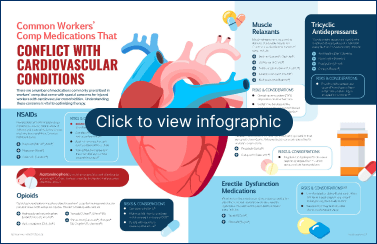Cardiovascular diseases (CVDs) include a wide range of health conditions impacting the heart and blood vessels. This can include coronary artery disease, cerebrovascular disease (e.g. stroke), and peripheral arterial disease, just to name a few.1 But certain risk factors for CVDs, such as high cholesterol and hypertension (high blood pressure), are comorbid health conditions in their own rights. And all these conditions can bring additional complexity in managing the health and treatment of injured workers.
Approximately
28.6 million
adults in the U.S. - 9.9% of adults - have some type of CVD, such as coronary artery disease, heart failure, stroke, etc.2
This jumps to an estimated
127.9 million
adults in the U.S.- 48.6% of adults - when adding hypertension2
1 in 20
adults have coronary artery disease3
1 in 5 deaths in the U.S. under the age of 65 are from heart disease4
adults in the U.S. – or 47.3% – have hypertension2,5
Hypertension, high cholesterol, and smoking are the “big three” risk factors for CVDs. However, other risk factors that can increase the likelihood of developing CVDs include:1-6
When considering the prevalence and impact of CVDs and related conditions in the workers’ comp population, age is a consideration when comparing to national statistics. In the U.S., CVD is most prevalent in individuals 75 years of age and older,8 an age range that – while relevant in today’s workforce – does not reflect a majority of the working population.
That being said, comorbid CVDs and hypertension have played a growing role in the management of workers’ comp claims over the last two decades – with negative impacts on cost, utilization of services, and lost time.9
There are many reasons for this. From a recovery standpoint, these comorbidities can directly prolong wound healing due to reduced or poor blood supply to the wound – increasing the risk for chronic wounds in people with high blood pressure or other vascular diseases.10 These patients may also require additional or special services. For example, people with CVDs are more likely to be seen in a cardiac rehab clinic for physical therapy services so that they can be monitored throughout their therapy sessions in the event anything goes wrong.
One key area where these comorbidities bring added complexity is in prescription drug management.

The presence of comorbidities such as CVDs, hypertension and high cholesterol in a workers’ comp claim can create complexity within drug therapy, as common medications prescribed within workers’ comp may come with additional safety and efficacy concerns when considered for these patients.
This may be due to drug-disease interactions between workers’ comp prescriptions and the comorbid condition itself, or even drug-drug interactions between the workers’ comp prescription and the medications prescribed outside of workers’ comp to manage comorbidities.
This is where enhanced visibility during a drug regimen review becomes important, because claims that are complex from a drug therapy perspective are often complex due to other factors.
An analysis of claims meeting criteria for drug regimen review revealed that: 11
Nearly a third also flagged for some form of CVD
More than two-thirds mentioned either hypertension or high cholesterol
Here, going beyond transactional pharmacy data to incorporate more complete health information, such as comorbidities, behavioral and social factors into the injured worker’s evaluation can more fully inform the clinician’s recommendations back to the prescribing doctor – helping reduce risk and optimize therapy.

There is a long list of prescription medications to treat various forms of CVD, hypertension, and high cholesterol. Below are some examples of therapies that may cause concerns alongside commonly prescribed workers’ compensation medications. Note this list is not exhaustive and is intended to provide examples of potential risk:
CV Drug
Metoprolol (Lopressor®)
What It’s For
A beta blocker used for multiple indications, including hypertension, heart failure, and angina
Drug Concerns in Workers’ Comp
NSAIDs, which are commonly prescribed in workers' comp, can result in impaired response to certain hypertension medications
CV Drug
Lisinopril (Qbrelis®, Zestril®, Prinivil®)
What It’s For
An ACE inhibitor, this drug lowers blood pressure by widening blood vessels to reduce workload for the heart
Drug Concerns in Workers’ Comp
NSAIDs, which are commonly prescribed in workers' comp, can result in impaired response to certain hypertension medications
Additive blood-pressure-lowering effects when combined with tizanidine (a skeletal muscle relaxant)
CV Drug
Atorvastatin (Lipitor®)
What It’s For
A statin used to lower cholesterol in the blood by reducing cholesterol production in the liver
Drug Concerns in Workers’ Comp
Statins can cause myopathy – a muscle disease where muscle fibers do not function properly – which can cause pain and weakness
CV Drug
Warfarin (Coumadin®, Jantoven®)
What It’s For
An anticoagulant used to treat blood clots
Drug Concerns in Workers’ Comp
Increased risk for bleeding when combined with NSAIDs

Considering how common cardiovascular diseases are, it is certainly a possibility that a significant portion of injured workers could have cardiovascular comorbidities, and that some are taking prescription medications for those conditions.
This highlights the importance of implementing clinical expertise in pharmacy management to promote the most effective care possible for injured workers. Additionally, tools and strategies that go beyond transactions to incorporate more complete health information, such as comorbidities, can generate additional context to drug regimen review. This helps reduce risk and optimize therapy.
Additionally, the field of cardiovascular medications is constantly evolving, and it is important to keep up to date with new drug approvals and clinical research to provide the most up-to-date and effective evidence-based care.
